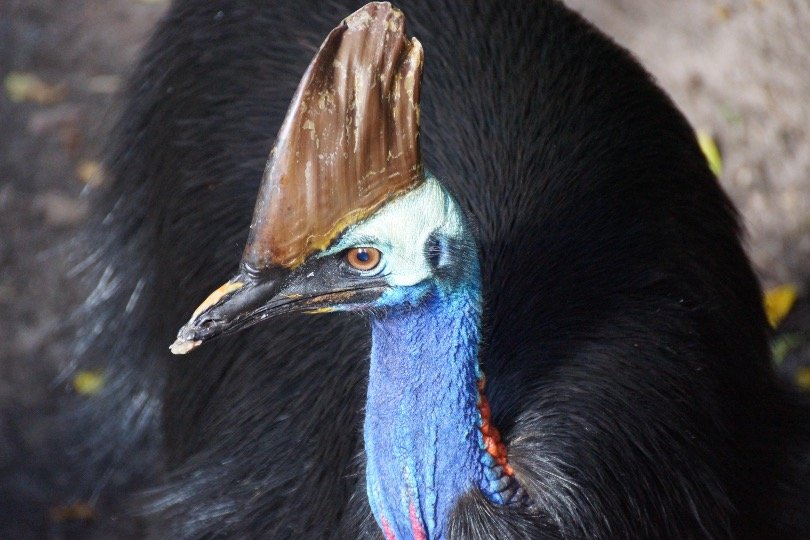
Cassowary Scientific Classification
- Kingdom: Animalia
- Phylum: Chordata
- Class: Aves
- Order: Casuariiformes
- Family: Casuariidae
- Genus: Casuarius
Raite, which includes the cassowary, is a long-legged, usually big, flightless bird that is a member of the Palaeognathae infraclass, which means “bird of prey.” Its wings are virtually non-existent, with only a few quills remaining on them.
The cassowary’s feathers are coarse, and some of them have filaments that look like hairs on the ends. As a result, the cassowary has been persecuted and is now being grown for its feathers. Female are larger than male, and the brilliant colours on their heads and necks are more vibrant than those on male.
Even more startling is the knifelike claw that protrudes from the inside of each foot’s toe. Although this primarily fruit-eating bird has weaker claws than most predatory birds, its talons are at least as formidable as those of the most strong of them.
Amazing Facts About the Cassowary!
• The male bird is in charge of rearing the chicks, and he is particularly hazardous when in father mode. He will not hesitate to use his claws to defend himself against predators and other potential threats.
• During a season, the female mates with two or three different males. After mating with them, she lays her eggs in their nest before moving on.
• Previously, biologists believed that cassowaries utilised the hard casques on top of their heads to push through the undergrowth in the rain forest, but scientists are no longer sure what the casque is for.
• In addition to booms and hisses, the bird can also rumble and roar and produce a variety of other sound effects.
• Recently, a dinosaur that looked strikingly similar to a cassowary was unearthed! Although the two species are not closely related, because cassowary relatives first developed 60 million years ago, they share ancient characteristics with only a few other animals alive today!
Habitat and Distribution of Cassowaries
In addition to New Guinea, this species can be found in Australia’s northeastern region and the Aru Islands, which are located between New Guinea and Australia. Despite the fact that they are huge birds, they are shy and difficult to locate in tropical rainforests.
You may also like to read;
Top 6 Smartest Birds: Everything You Need To Know
What Do Baby Birds Eat? Everything You Need To Know
Australia’s Paluma Range National Park, the McIlwraith Range National Park, and the Jardine River National Park have all been identified as having populations of these animals living there. Cassowaries can be found in a variety of zoos, which is a fortunate development. Among them are the following:
- The San Diego Zoo
- The Edinburgh Zoo
- The Denver Zoo
- The Perth Zoo
- The National Zoo
- The Natural Bridge Zoo
- The Los Angeles Zoo
Nests of the Cassowary
The male builds the bird’s nest out of fallen leaves that have accumulated on the ground. There are leaves or grass on the bottom of the pool, which makes it shallow. The male chases the female away from the nest after she has laid her eggs in it.
Scientific name of Cassowary
There are three different types. The following are their classifications:
• Casuarius casuarius, often known as the southern or double-wattled cassowary, is a species of cassowary native to southern Australia. A bird named Casuarius is derived from the Malay word kasuari, which means “bird” in English. The southern cassowary is designated as the type species for the bird under the classification Casuarius casuiarius. All other cassowary species are compared to it in terms of size and strength.
• Casuarius unappendiculatus, often known as the northern or single-wattled cassowary, is a species of cassowary native to northern Australia. One of the distinguishing characteristics of this categorization is that it has just one wattle, as opposed to the southern cassowary, which has two.
• Casuarius bennetti, often known as the Bennett’s cassowary, is a dwarf cassowary. When the bird was studied by a biologist, he discovered that it was a new species of cassowary, and thus the bird was given this name in honour of George Bennett.
Originally, a fourth species, the pygmy cassowary (Casuarius lydekkeri), existed, but it is no longer alive. There are no subspecies of birds that are still alive today.
Size, Physical Characteristics, and Behaviour of Cassowary
The southern cassowary is the largest of these species and, after its cousins the emu and the ostrich, it is the third largest bird in the world in terms of size. Its physical characteristics include a body that ranges in length from 40 to 72 inches, a height of 75 inches, and a weight of up to 187 pounds.
Its head is crowned by a horny casque that grows to be between 5 and 7 inches tall and expands with the bird as it matures. The size of a mature bird’s casque can be used to estimate the age of the bird. The bird has a vivid blue head and a red neck with two red wattles on either side of its neck.
Each long, scaly leg terminates in a three-toed foot, the inner toe of which carries the fatal claw, which can be up to 4.7 inches in length on the inside. In New Guinea, which comprises Papua New Guinea and Indonesia as well as the Aru Islands and Seram (an island that is part of Indonesia), cassowaries can be found in large numbers.
It has a population of over 2500 birds, although it is in decline. It is a shy and solitary creature that will scare away other cassowaries, except during the breeding season, if they are in the same territory. It feeds on fruit that has fallen to the ground and is capable of consuming fruit that is poisonous to other animals as well.
In addition to mushrooms and other fungi, the bird will consume small animals such as lizards. Despite the fact that it has a well-known claw, it does not use it to capture prey in the same manner that raptors do.
Although it is true that these birds will attack humans, they only appear to do so when provoked, terrified, defending eggs or chicks, or when they are under attack themselves. Several cassowaries have learned to identify humans with food and would just jump towards a human in the hopes of being fed.
The orange-gold or red neck of the northern cassowary, as well as its single wattle, distinguish it from other species. It is created in the same manner as the southern cassowary, although it is slightly shorter in stature and lighter in weight, with females weighing approximately 128 pounds in average weight.
It can only be found in coastal swamplands and lowland rainforests in northern New Guinea’s coastal lowlands. On the islands of Waigeo, Batanta, Yapen, and Salawati, there are also populations of this species. There are an estimated 10,000 to 20,000 of these birds in the wild, but their numbers are dropping, as is the case with the southern cassowary.
The northern cassowary, like the southern cassowary, preys on fruit and small animals that it may catch and feed in its mouth. It will also eat carrion, and the excrement of its father and siblings are consumed by their young. Indeed, mature birds have been observed to consume their own faeces if they still have undigested fruit in their stomachs.
Although the dwarf cassowary is the smallest of the cassowary species, it is by no means a little creature. Three to five feet in length and 39 to 53 inches in height are among the physical characteristics of the creature. It ranges in weight from 39 to 57 pounds.
The triangular casque of this cassowary is smaller in relation to its body than that of the northern and southern cassowaries. This creature has a vivid blue and crimson neck with pink cheeks on it. New Guinea, Yapen Island, and New Britain are home to this cassowary, which can be found at greater elevations than the northern or southern cassowaries.
The bird’s population size is unknown, but like the northern and southern cassowaries, it is considered to be of least concern in terms of conservation.
Diet of the Cassowary
Fruits, berries, fungus, and other plant elements are consumed by these birds. It is possible for them to consume plants that are otherwise harmful because food passes through their digestive tract very rapidly. Aside from small reptiles and amphibians, rats and mice, snails, and insects are all prey for these predators.
Predators and Threats to Cassowaries
The human being is the most serious threat to these birds. Humans kill them for their meat and feathers, and they are also killed accidently on the highways by vehicles. Dogs and pigs prey on their chicks, which fall to the ground when they sense danger.
Moreover, the cassowary’s habitat has been fragmented and devastated by logging and development, putting the species’ survival at risk. Diseases and natural disasters such as typhoons are among the other dangers that cassowaries must contend with.
Cassowary Reproduction, Babies, and Lifespan
The breeding season for cassowaries takes place in the winter and early spring months. Males will claim a territory, construct a nest, and court a female by vocalising and inflating his throat, as well as dancing in front of her as she watches.
If she welcomes him and does not drive him away, she will sit on the ground, and they will mate as a result of their acceptance. She will then deposit four to six green eggs in his nest, depending on the season. As soon as she’s finished, he’ll chase her away and incubate the eggs himself for approximately 47 to 56 days.
In the interim, the female will seek out another male to mate with. She’ll lay as many as 20 eggs until she’s done with her breeding cycle. Although they will be three years old before they have grown-up plumage, baby cassowaries remain with their fathers for nine months or until their first moult, depending on when they are born.
Some chicks stay with their fathers for as long as 18 months, according to the statistics. The down of the infant cassowaries is brown with black stripes, and it is very soft. If the father believes that the chicks are in danger from predators, he gets extremely hostile toward them.
Female cassowaries reach sexual maturity at the age of two, and male cassowaries reach sexual maturity at the age of three. Following that, they are capable of reproducing for several decades.
Females can reproduce until they are about 40 years old, while males can reproduce until they are about 35 years old. The cassowary with the longest known lifespan lived to be at least 61 years old.
Population of Cassowaries
Scientists are unsure of the exact number of cassowaries that exist in the wild, but the overall health of the species is of the utmost importance. The number of southern cassowaries is believed to be 20,000 to 50,000, whereas the number of northern cassowaries is up to 20,000. There is a decline in the populations of all three species.
Attacks by the Cassowary
Cassowaries have been dubbed “the most hazardous birds on the planet” by publications such as The Guinness Book of World Records, which describes them as “the most dangerous birds on the planet.” This assertion is based in part on the fact that there have been two documented human fatalities and more than 200 instances involving cassowaries.
In general, cassowary attacks are extremely infrequent. The majority of persons who have come have done so because they attempted to feed cassowaries, and the majority of occurrences involve the birds charging.
However, if a person is knocked to the ground by a cassowary, the situation can become quite perilous. There are some that can grow up to 5 inches in length and cause severe wounds, if not death, to humans.



Comments
Dr. Abdi Arif - April 25, 2022
very useful article